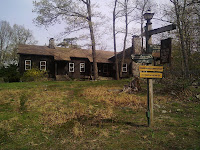The first thing we noted is there's a lot of metal, which equals weight. The Esbit Spirit cook set has a larger 985 ml cup than the 585 ml Esbit cup we use. Instead of the thin, light flat lid that comes with the 585 ml cup, the Esbit Spirit cook set comes with a second 470 ml pot, again more weight.
Directing our attention to the base beneath the 985 ml cup, we find the same heavy Esbit base, a brass Spirit alcohol stove, and an insert-able aluminum Esbit solid fuel burner - more weight. Yes, the entire cook set is made of hard anodized aluminum which is lighter than the steel cook sets offered in many outdoor shops, but there's still considerable excess weight.
The second thing we examined is the Spirit alcohol stove itself. It looks like the Spirit stove has small jets drilled into the top of the stove. If one can set the pot/cup directly atop the Spirit stove and still have a flame then Esbit's Spirit cook set is modifiable for use along the Appalachian Trail.If you absolutely insist on paying the greater cost for Esbit's Spirit cook set, then consider:
1) Keep the 985 ml cup/pot.
2) Try and buy a replacement flat lid from Esbit for their 585 ml cup and ditch the 470 ml pot/lid.
3) Ditch the base.
4) Keep the Spirit alcohol stove, but ditch the screw on lid and the other lid-like thing (flame snuffer?). Alcohol stoves have no moving parts to be protected and you don't (shouldn't) pack alcohol stoves with alcohol still in them.
5) Ditch the second aluminum Esbit solid fuel burner.
Personally, we wouldn't buy either the cook set nor the stove. Why would you want a 92 gram brass stove, when a Supercat alcohol stove is just 6 grams? Our Esbit 585 ml cup weighs just 113 grams compared to the Spirit cook set's 417 grams. Nothing against Esbit nor the brawny, he-man-y fellows who like to tote cool metallic toys over hill and dale, but a lighter pack makes for a more enjoyable hike
.Disclosure: We select and purchase the product(s) reviewed. We have no material connection to either the manufacturer nor the retailer(s).



























